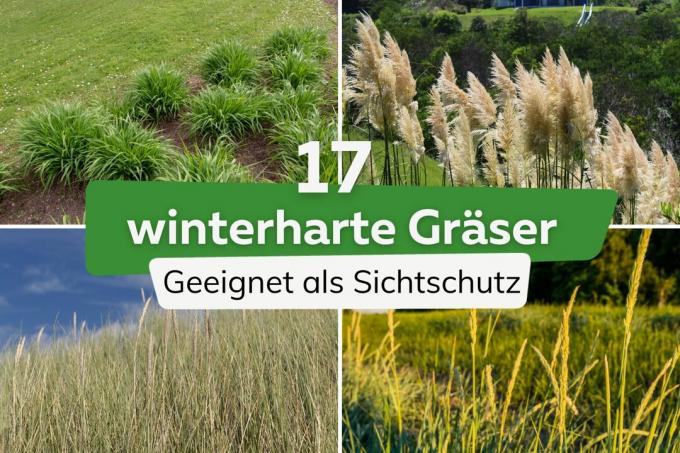
As a privacy screen, hardy grasses are a decorative and easy-care alternative, as they only need to be cut once a year. The variety of varieties is large and allows a varied hedge design.
In a nutshell
- Medium-sized grasses are an ideal privacy screen
- usually a rapid increase in height
- some evergreen or winter green grasses as a privacy screen
- Arrange grass in several rows for good privacy protection
Table of contents
- Hardy grasses from B to E
- F – G
- H-P
- R – S
- frequently asked Questions
Hardy grasses from B to E
Blue beach grass (Ammophila breviligulata)
The blue beach grass is ideal for drafty balconies. The leaves and stalks are robust and don't snap off easily, even in strong winds.

- growth height: 100-130cm
- Leaves: linear, pointed, grey-green
- Floor: dry, sandy, preferably with a high mineral content
Chinese reed (Miscanthus sinensis)
There are many cultivated forms of Chinese reed, with variable leaf and flower colors. Varieties with striped leaves, also known as "zebar reeds", are particularly attractive.
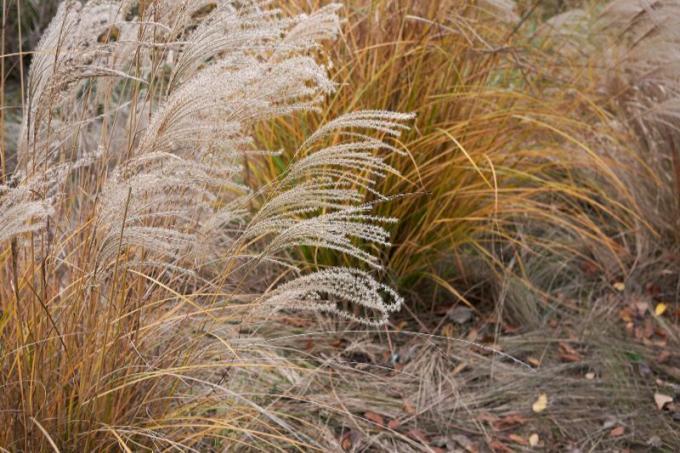
- growth height: 150-170cm
- Leaves: strap- or band-shaped, entire, tapering to a point
- Floor: humic, nutritious, permeable
elephant grass (Miscanthus giganteus)
Elephant grass grows compactly and quickly forms a privacy screen. It can form flowers when it is very hot in summer.

- growth height: 100-200cm
- Leaves: elongated, overhanging, fine
- Floor: well-drained, nutritious, moist to slightly dry, tolerates slightly acidic soil
A notice: Different Miscanthus species can be combined well. This allows you to achieve a varied look with a privacy screen.
F – G
feather bristle grass (Pennisetum alopecuroides)
Although the feather bristle grass does not grow very high, it is a popular hardy grass as a privacy screen for the balcony, as it forms very dense clumps. There it is, for example, in increased Planted in pots or tubsto reach the desired height.
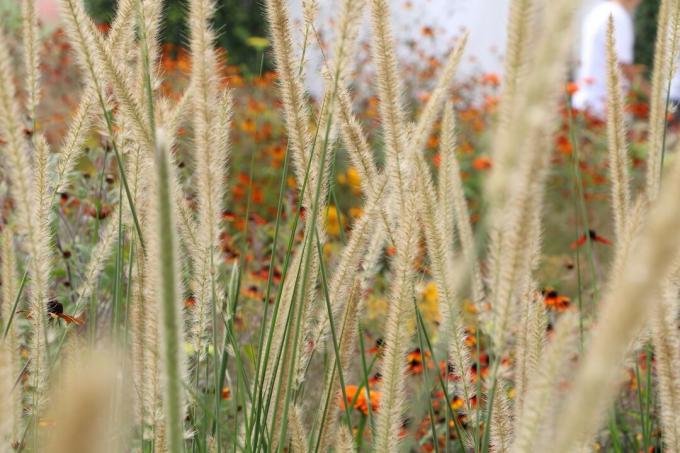
- growth height: 80-110cm
- Leaves: linear, entire, dull, tapering to a point
- Floor: fresh, nutritious, humic, well-drained, can also be sandy to loamy
Fountain screen bamboo (Fargesia nitida)
The fountain umbrella bamboo grows very quickly with up to 80 cm. Only older plants have the eponymous umbrella-like overhang.
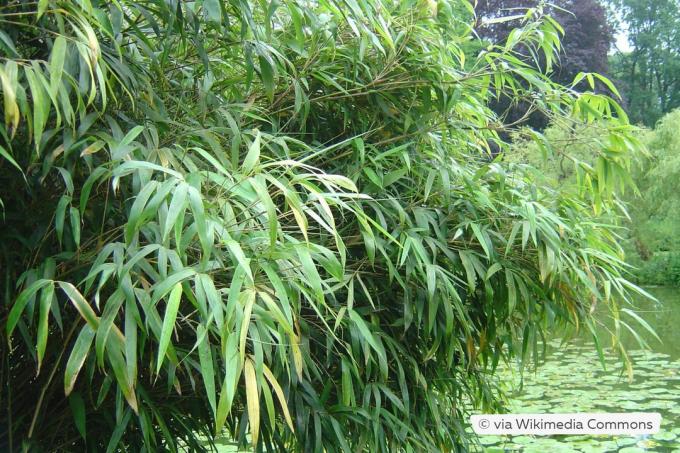
- growth height: 300-400cm
- Leaves: narrow, fine, evergreen
- Floor: permeable, nutritious
garden bamboo (Fargesia murielae)
The garden bamboo is one of the few types of grass that are evergreen. Compared to many other bamboo species, the garden bamboo forms significantly fewer rhizomes.
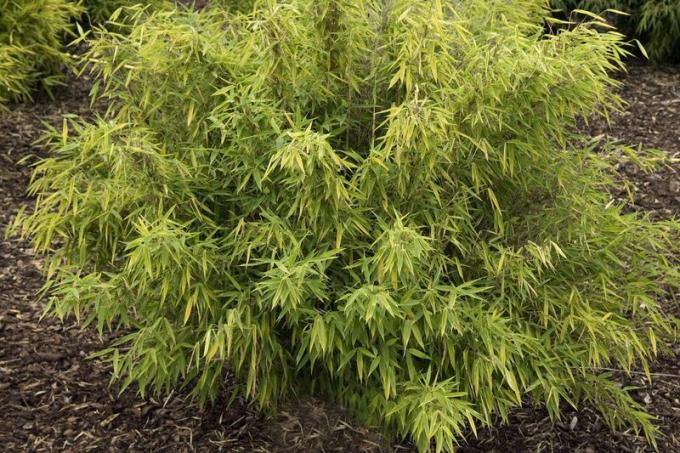
- growth height: 100-200cm
- Leaves: elongated, overhanging, fine
- Floor: well-drained, nutritious, moist to slightly dry, tolerates slightly acidic soil
Tip: You can easily propagate the garden bamboo yourself if you need more plants for privacy. To do this, separate pieces of root and plant them in nutrient-rich soil so that they can develop well.
Gerard's Bluehalm (Andropogon gerardii)
The Gerard's blue straw is characterized by a very good winter hardiness. The leaves are evergreen and range in color from blue-green to copper-red.
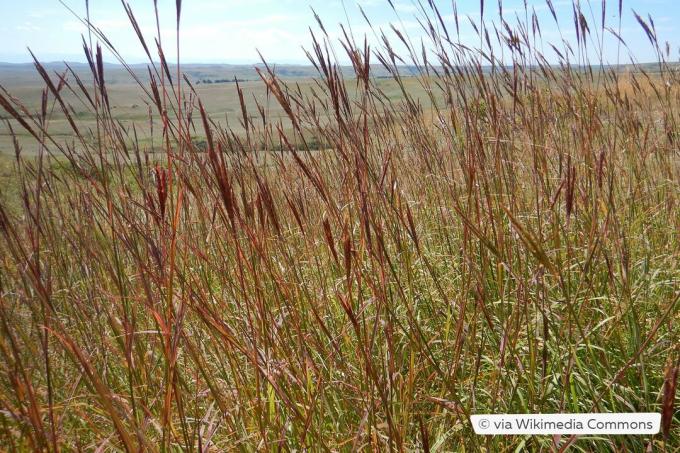
- growth height: 120-180cm
- Leaves: strap-like, smooth
- Floor: well-drained, dry to slightly moist, poor in nutrients
gold ribbon grass (Spartina pectinata)
The gold band grass also tolerates damp locations. It can be planted as a privacy screen in the area of swimming ponds.
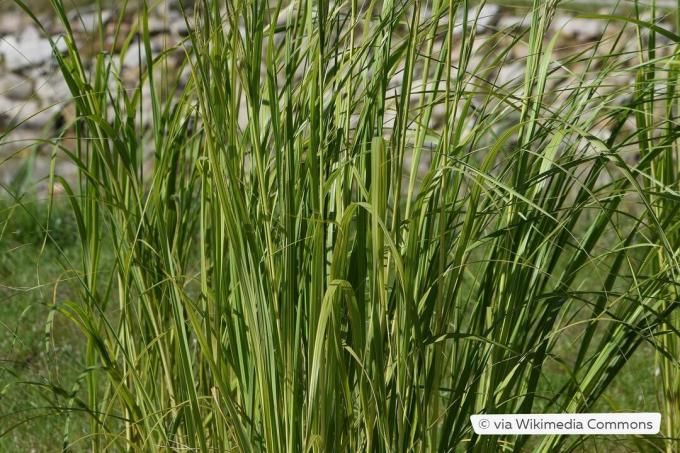
- growth height: 120-150cm
- Leaves: band-shaped, entire, tapering to a point
- Floor: loamy, nutritious, fresh to wet
H-P
Tall moor grass (Molinia arundinacea)
The grass has a loose growth and should be planted in groups as a hardy privacy screen. It can be arranged in several buckets on the balcony so that it also offers protection from unwanted looks.
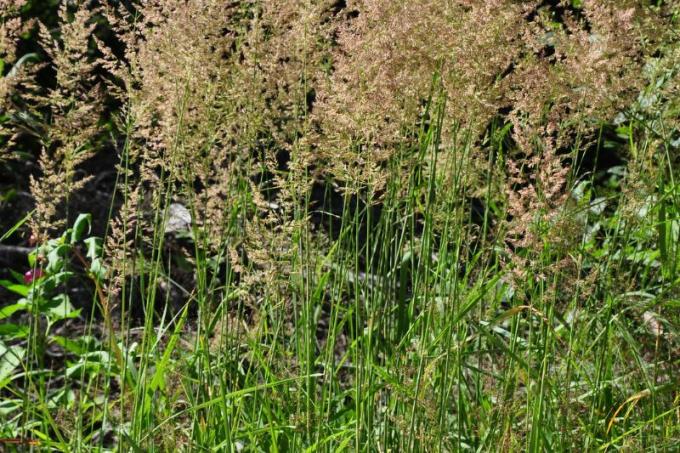
- growth height: 200-220cm
- Leaves: strap-like, dull, entire
- Floor: fresh to slightly moist, well-drained, lean
pampas grass (Cortaderia selloana)
The upright, bushy inflorescences of the pampas grass are an eye-catcher. In addition to white ones, yellowish or pink ones also bloom sorts cultivated.

- growth height: 200-250cm
- Leaves: strap-shaped, sharp-edged, narrow
- Floor: fresh, permeable, rich in nutrients
A notice: When planting pampas grass, good drainage is essential. The grass does not tolerate waterlogging and a safe drainage should also be guaranteed Culture in pots or tubs to be guaranteed.
pile pipe (Arundo donax)
The reed cane spreads quickly and requires a root barrier. It is a good windbreak and suitable for drafty balconies.
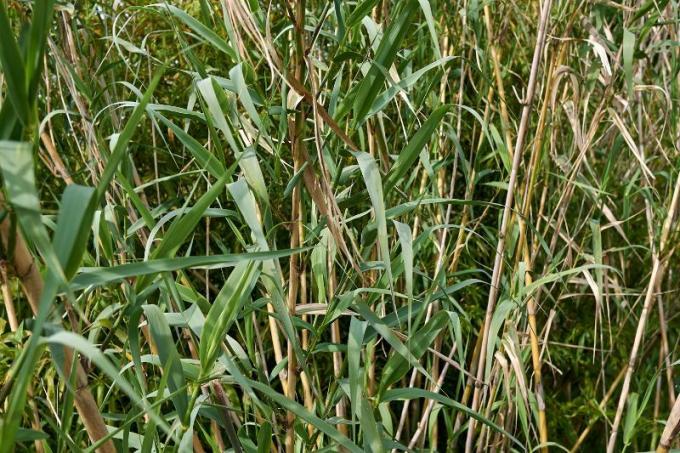
- growth height: 300-400cm
- Leaves: lanceolate, dull, tapering, arched
- Floor: fresh to moist, humic, nutritious
R – S
riding grass (Calamagrostis x acutiflora)
The riding grass should be planted in several rows as a privacy screen so that it is opaque. The loose flower panicles ensure a certain lightness and the panicles remain with the fruit decoration until winter.
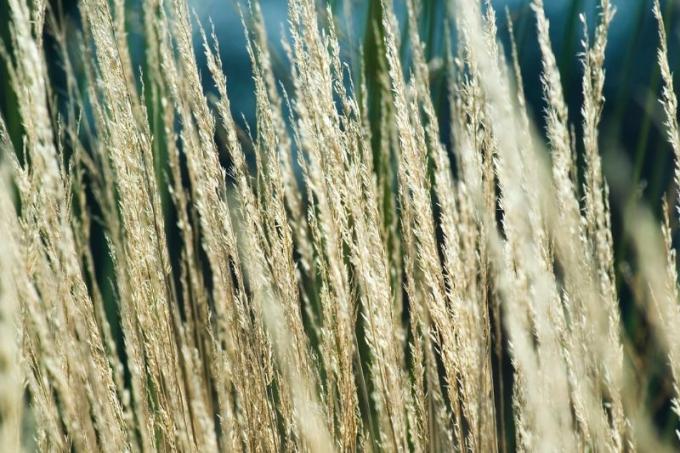
- growth height: 50-150cm
- Leaves: long, wide, tapering
- Floor: fresh, well drained, normal garden soil
giant forest sedge (Carex pendula)
The giant forest sedge is suitable for semi-shady to shady locations. Due to its strong and overhanging growth, it forms a reliable privacy screen within a short time.

- growth height: 40-120cm
- Leaves: strap-shaped, shiny, tapering
- Floor: fresh to slightly moist, loamy, often chalky
Pipe moor grass (Molinia arundinacea)
The inflorescences of the moor grass can easily reach more than two meters. The clumps themselves remain rather small and reach a height of around 60 cm.

- growth height: 120-240cm
- Leaves: linear, narrow, overhanging
- Floor: fresh to slightly moist, nutritious
switch millet (Panicum virgatum)
The switch millet is ideal for the balcony or terrace. Arranged in groups, it offers good privacy.
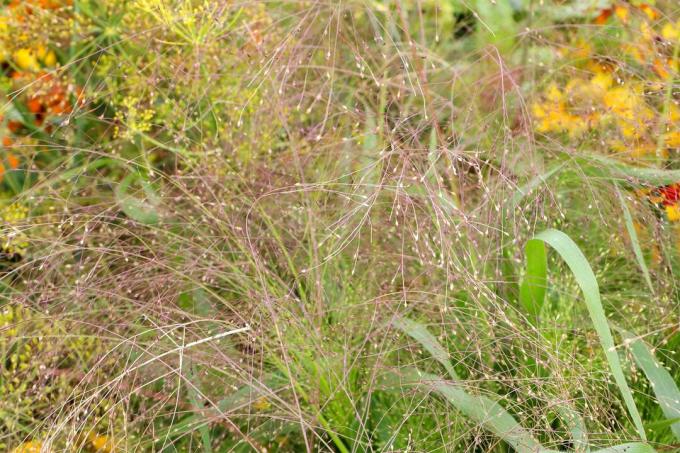
- growth height: 130-150cm
- Leaves: linear, dull, soft, tapering
- Floor: fresh, well drained, normal garden soil
Silver Beard Grass (Andropogon ternarius)
Silver Beard Grass is almost hypnotic when gently swayed by the wind. The grass is very frost hardy and easy to care for.

- growth height: 100-150cm
- Leaves: linear, hairy, tapering
- Floor: well drained, normal garden soil
beach rye (Leymus arenarius)
The beach rye is ideal for a Mediterranean balcony or terrace. The grass is very drought tolerant and the blue-grey color remains in winter.

- growth height: 100-130cm
- Leaves: band-shaped, stiff, frosted
- Floor: dry, well drained, moderately humic and rich in nutrients
A notice: The beach rye has slightly prickly leaves. This makes it suitable as protection for peripheral areas in the garden.
frequently asked Questions
The space required depends on the type. When growing in tubs or pots, the pot diameter should be at least 50 cm. In this way, the grasses can form beautiful clumps and many stalks as privacy screens.
Most grasses reach their average height early. There are differences in width growth. Grasses that only form clumps should be planted in smaller groups so that they form a screen more quickly. For some species it is advisable to plant in several rows so that the view of the area behind is reliably blocked. After pruning, it takes two to three months for the grass to grow back to its full height and be a privacy screen.
Yes, although the grasses are hardy, they don't have the opportunity to root themselves so deeply in the bucket or pot that the low temperatures can't harm them. Grasses in pots should be overwintered in an unheated greenhouse or the root ball must be protected from frost with a jute sack. Do not forget to water the grasses in the pot on frost-free days in winter so that they do not dry out.

